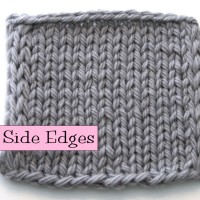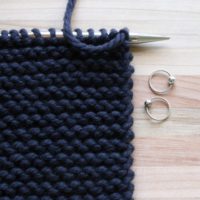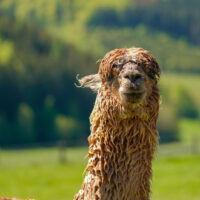So many choices with needle shapes and types – what are the differences? Circular needles vs. straight needles, fixed circulars vs. interchangeable sets, different cord lengths? In this video I talk about all of that, including my personal preferences.
Information on things you’ll see in this video:
The Log Cabin Blanket quilt block is a free pattern and video tutorial.
The 16″ circular needle set can be found here.
The Platina needle set can be found here.
My sweater is store bought. 🙂






When I decided to invest in my first interchangeable circular needle set, the knitting store suggested the Addiclick lace set with shorter needles because it comes with a 16″ cord and I like to make hats. Now I use this set for everything! I don’t mind the short needles.
Staci, Whether you use circular needles, dpns or straight needles for flat knitting, what is your advice for avoiding rowing out when doing stockinette? I understand the physics behind why rowing out happens and that the object is try to get the same tension on knit and purl stitches and there’s a lot of advice out there on different techniques to accomplish that. I just wondered what your advice would be. Thanks.
Peggy – sorry, I don’t have any advice for you, as I’ve never heard of “rowing out”!
S t a c i
Could u please do a video on blocking possibly using the log cabin blocks?
I also use only circular needles. I have been looking for set of 16″ cords but have been unable to find them. Where did your get yours…also do they come in lace points…….also can you get JUST set of lace points to fit my set of circular needles. Enjoy your videos. Thanks, JO Ann. Chandler
Jo Ann – I’m not actually a retailer…you’ll probably do better with these questions at your local yarn shop, or someone who is very familiar with what is and is not available for purchase.
S t a c i
Staci. could u tell how to a 3needle bind off am getting ready to a shoulder for sweater thank u joy prewitt
Staci, Could u please tell me how to do a 3needle bind off. Am getting ready to shoulders on a sweater thank u joy
Joy – here you go: https://verypink.com/2010/09/28/3-needle-bind-off/
Peggy – first, you have to check, whether your knit or purl rows are the looser ones. (The most common way is that the purl rows are looser, but there are exceptions to this. Everybody’s knitting style is individual.)
When using interchangeables, I just screw in two different needle sizes (one being 1 size smaller than the other) and make sure I use the smaller needle for the purl rows (my purl rows are looser, so I have to make up for that by using the smaller needle).
Important is, that I use this exact needle constellation when swatching for my piece! This way I can look at the wrong side of the swatch and see if the rows are even – sometimes it will not work with the individual combination of yarn, needle material and needle sizes.
(I have figured out on various swatches, that my gauge also differs quite a bit when comparing metal vs. wood needles. Thus, I use this fact to use, for example, the same size needles, but a wooden one for knit and a metal pne for purl rows, which is the great thing about the knitter’s pride needles all working together from the different sets.) I hope this helps.
Really, trying and swatching is the key to which combination will work.
Staci – FYI, “rowing out” is the terminus for the effect that you get when you are knitting a flat stockinette piece, because many knitters have a different tension for knits and purls. It is very visible on the wrong side of the work, when you stretch it a little bit lengthwise: you will see, that the reverse stockinette rows don’t appear to have even spacing. Instead, they appear in ridges of 2, because every second row is a little bit looser than the one before.
I have found one use for knitting with straight needles that works much better for me than circulars. A (non-knitting) friend gave me a hank of Shibui Silk Cloud (lace weight, brushed mohair) with a scarf pattern for Christmas. The stickiness of the mohair made it impossible to correct any mistakes in the pattern beyond the current row (and even that was tedious beyond words). Even lifelines would have been a nightmare. So, I found that knitting it on straight needles made it easier for me to hold it up and check the pattern, count the stiches easily, each row to be sure I didn’t make a horrible error. Yes, it was slow going, and I probably wouldn’t have chosen the yarn, but the results were worth it. It’s like knitting a kitten.
Thanks for the explanation on cord length. I suppose that the shorter cord length would be great for mittens, but maintaining proper gauge seems like a nightmare if the needles are so short. Maybe if they have a cord that is same circumference (?)
The 16 inch fixed needles available in my local store work great for my hats and I have enough of them in a few different sizes that I can just use different needles. The yarn just slides so nicely–I swear I have fallen asleep and continued to knit a few rows. oO
Straight needles and DPNs are not used very much anymore as they are just clumsy for me, but of course I might need them again for a future project.
Since you are not the klutz I am, there’s no need for you to mention the biggest advantage for me using circular needles: When I drop one, it doesn’t hit the floor and roll away! (grin) I just retrieve it from the end of the cord and go on.
Hi Staci,
First, I love your videos! I also love Knitter’s Pride Dreamz needles, however, the 16″ set doesn’t have larger sizes. Do you have any recommendations for 16″ circular but US size 13, 15, and 17? I want to make a chunky knit cowl for a teenager who is petite so I’m thinking that roughly 20″ in circumference will be enough.
Thanks,
Isla
I love using circular needles on a project when I am traveling with it that way I don’t have to worry about losing the needle that is not holding the work or dropping the needle on the plane, etc.
Does anyone have recommendations for circular needle sets? I looked at Deborah Norville’s in a catalog, but just don’t trust “kneedles”…..Thanks!